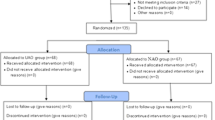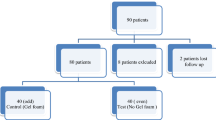Abstract
In a retrospective study of patients who had undergone myringoplasty at our department within a 12-month period, we assessed the graft take rate using tri-adcortyl ointment (TAO) as ear dressing. Data including age, site and size of perforation, grade of surgeon, surgical approach, use of postoperative ear dressings, complications and audiometric outcome was collected from the patient notes and analysed. The overall success rate of the operation (with success being defined as an intact tympanic membrane at 6 months) was noted. Seventy-seven patients were operated, but data were complete on 64 patients and these constituted the study population. TAO was used in 95% of the patients and BIPP gauze pack in the remaining 5%. Age ranged from 8 to 63 years (mean 34 years). Mean follow-up period was 13 months. Most of the operations (72.88%) were carried out by consultants with a success rate of 89% and the remaining patients were operated by trainees with a success rate of 88% (P = 1.000). The overall success rate was 89, 90.16% for TAO and 66.66% (2 out of 3) for BIPP (P = 0.298), 95% for small and 86% for subtotal perforations (P = 0.573), 85% for anterior and 100% for posterior perforations (P = 0.240), 91% for adult patients and 88% for children (P = 1.000). TAO is a suitable ear dressing in myringoplasty. Routine use of TAO did not affect the success rate of myringoplasty at our centre.
Similar content being viewed by others
References
Kotecha B, Fowler S, Topham J (1999) Myringoplasty: a prospective audit study. Clin Otolaryngol 24:126–129
Yung MW (1995) Myringoplasty for subtotal perforations. Clin Otoalryngol 20:241–245
Onal K, Uguz MZ, Kazikdas KC, Gursoy ST, Gokce H (2005) A multivariate analysis of otological, surgical and patient-related factors in determining success in myringoplasty. Clin Otolaryngol 30(2):115–20
Zeitoun H, Sandhu GS, Kuo M, MacNamara M (1998) A randomized prospective trial to compare four different packs following permeatal middle ear surgery. J Laryngol Otol 112:140–144
Lee P, Kelly G, Mills RP (2002) Myringoplasty: does size of the perforation matter? Clin Otolaryngol 27:331–334
Karkanevatos A, De S, Srinivasan VR, Roland NJ, Lesser TH (2003) Day-case myringoplasty: five years’ experience. J Laryngol Otol 117(10):763–765
Caylan R, Titiz A, Falcioni M, De Donato G, Russo A, Taibah A, Sanna M (1998) Myringoplasty in children: factors influencing surgical outcome. Otolaryngol Head Neck Surg 118(5):709–713
Sheehy JL, Anderson RG (1980) Myringoplasty—a review of 472 cases. Ann Otol 89:331–334
McRae D, Dilkes M, Kenyon G (1992) The pope wick as a myringoplasty ear canal dressing. J Laryngol Otol 106: 327–328
Morison R (1916) The treatment of infected suppurating war wounds. Lancet ii:268–272
Nigam A, Allwood MC (1990) BIPP—how does it work? Clin Otolaryngol 15:173–175
Nigam A, Ruddy J, Robin PE (1991) BIPP induced methaemoglobinaemia. J Laryngol Otol 105:78–79
Acknowledgments
The authors are grateful to Yemisi Takwoingi of the Birmingham Clinical Trials Unit, University of Birmingham, for assisting with the statistics, and to Diane Lynch of the Department of Clinical Effectiveness Audit, Sandwell and West Birmingham NHS Trust for helping with data collation.
Author information
Authors and Affiliations
Corresponding author
Rights and permissions
About this article
Cite this article
Anderson, O., Takwoingi, Y.M. Tri-adcortyl ointment ear dressing in myringoplasty: an analysis of outcome. Eur Arch Otorhinolaryngol 264, 873–877 (2007). https://doi.org/10.1007/s00405-007-0284-2
Received:
Accepted:
Published:
Issue Date:
DOI: https://doi.org/10.1007/s00405-007-0284-2




